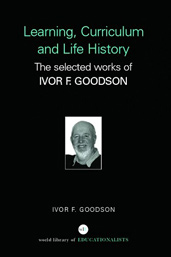Learning, Curriculum and Life Politics: the selected works of Ivor F. Goodson
Towards an Alternative Pedagogy
Classroom Learning
The assumption which underpins transmission pedagogy is that what is decided in the pre-active context can be made to work in the interactive context (Jackson 1968, p.152). I want to question this assumption and argue that what is decided at the pre-active stage of curriculum planning is commonly contradicted and subverted at the interactive stage.
The assumption that pre-active decisions can and should be made to work in the interactive context is inevitably allied to the belief that learning consists of the child coming to accept and understand the teacher's expositions and definitions. In arguing that pre-active decisions seldom stand up in the interactive context I am by implication arguing for a new model of classroom learning. Modern studies of learning show how information is idiosyncratically processed by each learner. Recognition of the uniqueness of individual processing and of the variability of interests is the prerequisite of any understanding of classroom life and of any move to describe a new pedagogy. The new pedagogy would seek to define a strategy which sensitized the teacher to individual processes and interests and positioned his response to these at the centre of his teaching: broad collective plans and decisions would be ancillary to this central response.
In many ways the new pedagogy would be seeking to formalize at the theoretical (pre-active) level what already sometimes goes on at classroom (interactive) level: as we have argued, transmission is commonly subverted in the classroom. Studies of classroom interaction offer boundless evidence of such recurrent subversion. Philip Jackson's studies of Life in Classrooms are widely regarded for their authentic flavour:
As typically conducted, teaching is an opportunistic process. That is to say, neither the teacher nor his students can predict with any certainty exactly what will happen next. Plans are forever going awry and unexpected opportunities for the attainment of educational goals are constantly emerging. The seasoned teacher seizes upon these opportunities and uses them to his and his students' advantage... in the classroom as elsewhere, the best laid schemes suffer their usual fate (Jackson 1968, p. 166).
The unpredictability of classroom life described by Jackson explains the most common classroom phenomena: one group of children working along the lines the teacher has laid down (e.g. listening, answering or filling in the worksheet); some just going through the motions by copying out bits or doodling, and another group thoroughly alienated, talking among themselves, staring out of window, thinking of last night at the disco.
This range of responses is what most teachers will readily recognize as the 'reality' of their classrooms. The myth of transmission has it that it is only the teacher's inadequacy that explains why more children are not working along pre-determined lines. I am arguing that the recurrent failure to involve so many children in classroom learning can be most convincingly explained by fundamental flaws in the transmission model. A pedagogy so firmly situated in the pre-active vacuum can only expect partial success, given the variabilities of interactive reality; no pedagogy so all - dependent on prediction could hope to encompass the diversity of the classroom.
